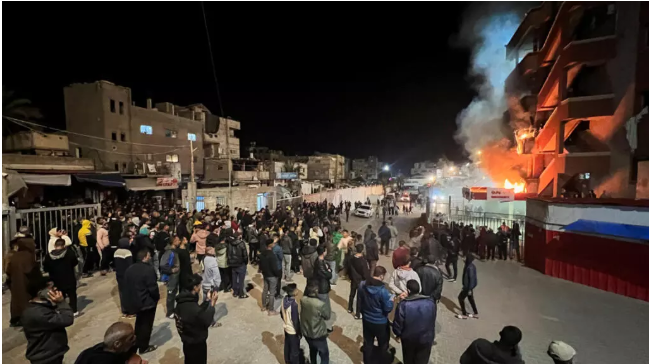
Escalation in Gaza Conflict as Israeli Forces Strike Key Locations
In a significant escalation of the ongoing conflict, Israeli forces launched a precision strike on the largest hospital in southern Gaza, reportedly targeting a senior Hamas leader. The attack, which has drawn widespread international attention, marks a critical moment in the intensifying tensions between Israel and Hamas. Here is a detailed breakdown of the events and their implications.
The Incident: What Happened?
Early reports indicate that Israeli military aircraft carried out the strike on the hospital in Khan Younis, a densely populated city in southern Gaza. The facility was reportedly being used as a command center by Hamas operatives, according to Israeli military sources. The strike resulted in significant casualties, including the death of a high-ranking Hamas official whose identity has not yet been disclosed.
The hospital, a vital healthcare facility for the region, sustained severe damage, raising concerns about the immediate impact on civilians and the already strained medical infrastructure in Gaza. Eyewitness accounts describe chaotic scenes as medical staff and civilians scrambled to evacuate the wounded amidst the rubble.
International Reactions and Condemnation
The attack has sparked a wave of international criticism. The United Nations and several humanitarian organizations have expressed grave concerns over the targeting of a medical facility, emphasizing the importance of protecting civilians and adhering to international humanitarian law. Calls for an immediate ceasefire have intensified as global leaders urge both parties to de-escalate the violence.
Meanwhile, Israel has defended its actions, stating that the hospital was being exploited by Hamas as a shield for its operations. Prime Minister Benjamin Netanyahu reiterated that Israel remains committed to dismantling Hamas’s military infrastructure while minimizing harm to civilians.
The Strategic Context
The targeting of a hospital underscores the complexity of the conflict, where civilian infrastructure often becomes entwined with military objectives. Israel’s military strategy has increasingly focused on neutralizing Hamas’s leadership and operational capabilities, even as the group continues to embed itself within densely populated urban areas.
Hamas, designated as a terrorist organization by Israel, the United States, and the European Union, has utilized hospitals, schools, and residential areas for its operations, complicating Israel’s military campaigns. This latest strike highlights the ongoing challenges of urban warfare in Gaza and the devastating toll it takes on civilian populations.
Humanitarian Crisis Deepens
The destruction of the hospital exacerbates an already dire humanitarian situation in Gaza. With limited access to medical supplies, food, and clean water, residents face worsening conditions as the conflict drags on. The World Health Organization (WHO) has warned of an imminent health crisis, calling for immediate access to humanitarian aid.
Local and international aid agencies have reported difficulties in delivering essential supplies due to the continuous airstrikes and blockade. The closure of the Rafah border crossing, a critical lifeline for Gaza’s population, has further restricted movement and access to assistance.
Regional and Global Implications
The strike on the hospital has significant regional implications, potentially inflaming tensions in the broader Middle East. Neighboring countries, including Egypt and Jordan, have condemned the attack and urged Israel to exercise restraint. Protests have erupted across the region, with demonstrators expressing solidarity with the people of Gaza and demanding an end to the violence.
The United States and European nations have called for a renewed focus on diplomatic efforts to address the root causes of the conflict. However, the path to a lasting resolution remains fraught with challenges, as deep-seated grievances and competing political interests continue to hinder progress.
Moving Forward: The Need for Dialogue
As the conflict escalates, the need for dialogue and a negotiated settlement becomes increasingly urgent. International mediators, including the United Nations and regional actors, must intensify their efforts to bring both sides to the negotiating table.
A sustainable solution requires addressing the underlying issues, including the blockade on Gaza, the status of Jerusalem, and the broader Israeli-Palestinian conflict. While immediate measures to protect civilians and ensure humanitarian access are critical, long-term peace will only be achieved through mutual recognition and compromise.
Conclusion
The strike on the hospital in southern Gaza represents a pivotal moment in the ongoing conflict, highlighting the devastating human cost of the violence. As the international community grapples with the complexities of the situation, the focus must remain on protecting civilians, ensuring accountability, and fostering conditions for a lasting peace.
In the face of escalating hostilities, the resilience and determination of those affected by the conflict serve as a stark reminder of the urgent need for a comprehensive and just resolution. The world watches as Gaza endures yet another chapter of suffering, hoping for a day when peace and stability will prevail in the region.
